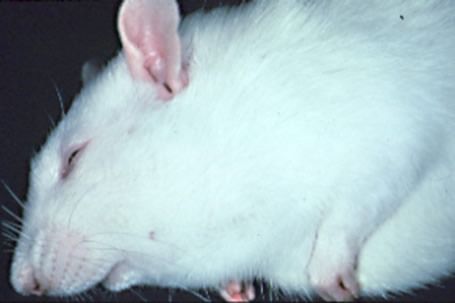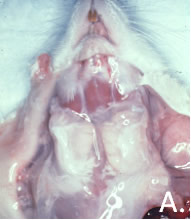Etiology: Coronavirus is an enveloped RNA virus with two strains identified to cause disease in rats. Rat coronavirus (RCV or Parker’s rat coronavirus) causes respiratory infection while sialodacryoadenitis virus (SDAV) infects the upper respiratory tract, Harderian and exorbital lacrimal glands, and the submandibular and parotid salivary glands. Pulmonary disease is possible in young rats with SDAV.
Incidence: Incidence of infection is low.
Transmission: RCV/SDAV is highly contagious and is spread by aerosol, direct contact, and fomites.
Clinical Signs: Coronaviral infections are generally subclinical but can cause clinical disease in immunodeficient rats. Infected rats may exhibit a porphyrin oculonasal discharge. The submandibular salivary gland may be palpably enlarged due to sialoadenitis (see photo). Dacryoadenitis may cause exophthalmos, which can lead to exposure keratitis and corneal ulcers.

Pathology: Lesions include enlarged submandibular and parotid salivary glands (A.), edematous cervical lymph nodes, swollen lacrimal glands, and yellow-grey foci in Harderian glands.

Histopathologic examination of submandibular salivary glands reveals degenerative changes including acinar and ductal epithelial necrosis, interstitial edema, squamous metaplasia of ductular epithelium followed by proliferation of hyperchromatic acinar cells. Chronic lesions include replacement of acini with fibrous connective tissue and an infiltration of lymphocytes. Similar lesions are present in the lacrimal and Harderian glands. The sublingual salivary gland (mucous gland) is usually not affected.
Diagnosis: The most common diagnostic test is serologic screen using MFI and IFA. Coronavirus PCR assays will help detect RCV or SDAV in acute infections. SDAV PCR samples include Harderian gland or submandibular salivary gland. Lung is the optimal sample for PCR testing of RCV.